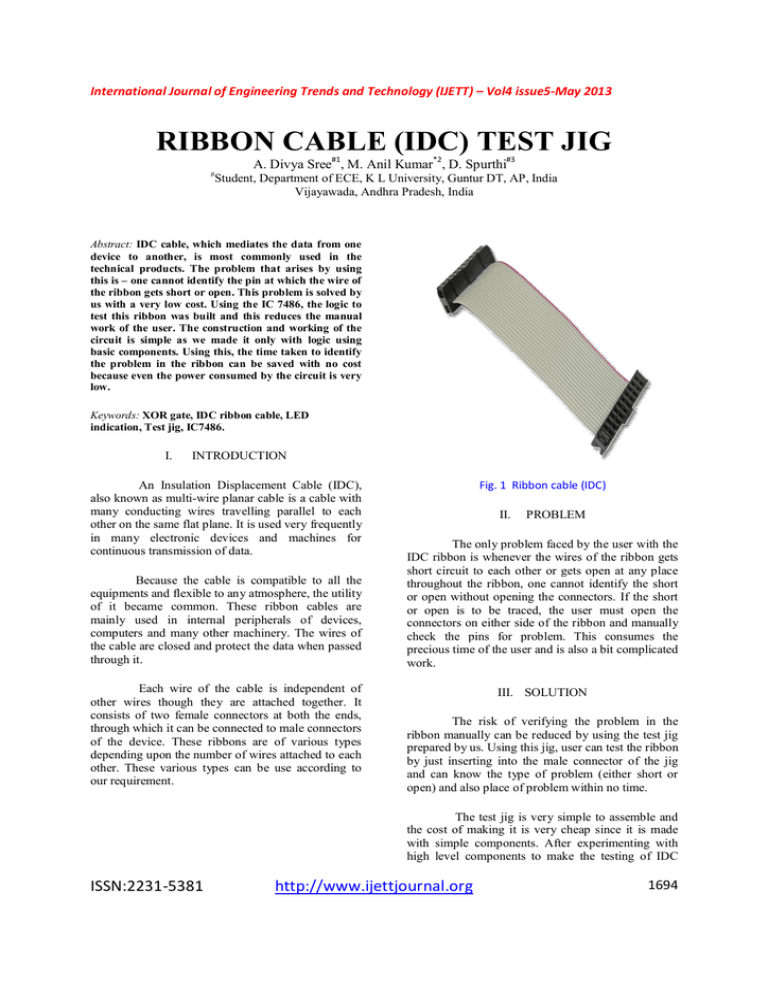RIBBON CABLE (IDC) TEST JIG A. Divya Sree
advertisement

International Journal of Engineering Trends and Technology (IJETT) – Vol4 issue5-May 2013 RIBBON CABLE (IDC) TEST JIG A. Divya Sree#1, M. Anil Kumar*2, D. Spurthi#3 # Student, Department of ECE, K L University, Guntur DT, AP, India Vijayawada, Andhra Pradesh, India Abstract: IDC cable, which mediates the data from one device to another, is most commonly used in the technical products. The problem that arises by using this is – one cannot identify the pin at which the wire of the ribbon gets short or open. This problem is solved by us with a very low cost. Using the IC 7486, the logic to test this ribbon was built and this reduces the manual work of the user. The construction and working of the circuit is simple as we made it only with logic using basic components. Using this, the time taken to identify the problem in the ribbon can be saved with no cost because even the power consumed by the circuit is very low. Keywords: XOR gate, IDC ribbon cable, LED indication, Test jig, IC7486. I. INTRODUCTION An Insulation Displacement Cable (IDC), also known as multi-wire planar cable is a cable with many conducting wires travelling parallel to each other on the same flat plane. It is used very frequently in many electronic devices and machines for continuous transmission of data. Because the cable is compatible to all the equipments and flexible to any atmosphere, the utility of it became common. These ribbon cables are mainly used in internal peripherals of devices, computers and many other machinery. The wires of the cable are closed and protect the data when passed through it. Each wire of the cable is independent of other wires though they are attached together. It consists of two female connectors at both the ends, through which it can be connected to male connectors of the device. These ribbons are of various types depending upon the number of wires attached to each other. These various types can be use according to our requirement. Fig. 1 Ribbon cable (IDC) II. PROBLEM The only problem faced by the user with the IDC ribbon is whenever the wires of the ribbon gets short circuit to each other or gets open at any place throughout the ribbon, one cannot identify the short or open without opening the connectors. If the short or open is to be traced, the user must open the connectors on either side of the ribbon and manually check the pins for problem. This consumes the precious time of the user and is also a bit complicated work. III. SOLUTION The risk of verifying the problem in the ribbon manually can be reduced by using the test jig prepared by us. Using this jig, user can test the ribbon by just inserting into the male connector of the jig and can know the type of problem (either short or open) and also place of problem within no time. The test jig is very simple to assemble and the cost of making it is very cheap since it is made with simple components. After experimenting with high level components to make the testing of IDC ISSN:2231-5381 http://www.ijettjournal.org 1694 International Journal of Engineering Trends and Technology (IJETT) – Vol4 issue5-May 2013 automatic, we learnt that this can be made too easy even with basic components. The material used to make the test circuit is a general purpose PCB, IC 7486 (XOR gate), resistors (value depends on the voltage used, but generally need 200 ohms for 5v source) 3 mm. LEDs and a male connector. Fig. 4 Practical circuit for test jig Fig. 2 IC74HC86 (XOR gate IC) The pin diagram of IC 7486 with four XOR gates appears as shown below Fig. 5 Soldered side of the jig Fig.3 Pin diagram of IC7486 This IC consists of 14 pins and four twoinput XOR gates. As shown above, seventh pin is grounded and power supply will be given to fourteenth pin. First and second pins of the IC are the inputs of first XOR gate and third pin is the output of it. Other three gates work in the same manner. Generally, using 3 mm. LED with five volts power supply requires 200 ohms resistance. A. Construction: Here in our test jig, the odd pins of male connector in the circuit are given logic ‘1’ and even pins are given logic ‘0’( here ‘1’ indicates +5v and ‘0’ indicated GND). From the same connector, pin 1 is connected to first pin of IC 7486 and pin 2 is connected to second pin of IC. Now, the third pin of the IC is connected to LED via resistor. In the same way, pin 3 of connector is connected to fourth pin of the IC and pin 4 to fifth pin. Sixth pin of the IC is connected to LED through a resistor. These connections continuous according to the number of wired ribbon used. The negative end of the LED will be grounded. The number of ICs required depends on the number of wires present in the ribbon. B. Working: The basic logic behind this circuit can be understood by knowing the truth table of XOR gate. ISSN:2231-5381 http://www.ijettjournal.org 1695 International Journal of Engineering Trends and Technology (IJETT) – Vol4 issue5-May 2013 V. CONCLUSION As the Insulation Displacement Cable is used widely in the electronic world, our interest to make the process of testing it easy made this jig and it is being used by us in practice. In this competitive world, every minute is precious and the perfect industrialist goes on improves his business by not only travelling with the standard process of manufacturing products but also should focus on the methods to make the same work easy with the constant quality and less expenses. Keeping the same idea in mind, the test jig for the IDC ribbon, which saves the golden time of the user, is created by us, which costs very less. ACKNOWLEDGEMENT This paper is made possible through the help of my guides Ms. D. Spurthi and Mr. M. Anil Kumar. I thank them for their technical support. I also thank my parents for their continues encouragement. Fig. 6 XOR gate representation and its truth table By inserting the female connector of the ribbon into the male connector of test jig, due to the connections i.e. logic ‘1’ to odd pins and logic ‘0’ to even pins, the input of XOR gate appear as ‘1’ and ‘0’ which makes the output of ‘1’ and makes the LED glow. If there exists any short or open, the inputs will be either ‘1’ and ‘1’ or ‘0’ and ‘0’, which makes the output ‘0’ and the LED does not glow. This indication of the LED not glowing resembles problem in the pins of the ribbon wires connected to that particular LED via IC. By this way, one can easily find the faults in the ribbon within seconds and solve the problem in flexible manner. IV. ADVANTAGES REFERENCES [1] Details of the ribbon can be studied by http://en.wikipedia.org/wiki/Insulationdisplacement_connector. [2] Various types of ribbons can watched in http://www.google.co.in/search?q=idc+cable&hl =en&tbm=isch&tbo=u&source=univ&sa=X&ei =zd92UZTSGIiMrQf644DwBw&sqi=2&ved=0 CD4QsAQ&biw=1366&bih=616 [3] Exclusive OR gate can be understood by http://lyle.smu.edu/~lli/Lab1/lab_equip_notes.pd f. 1. Saves the time of the user. 2. Manual work can be reduced. 3. Consumes low power. 4. Ribbon may not be wasted due to problem. 5. Flexible testing occurs. ISSN:2231-5381 http://www.ijettjournal.org 1696




